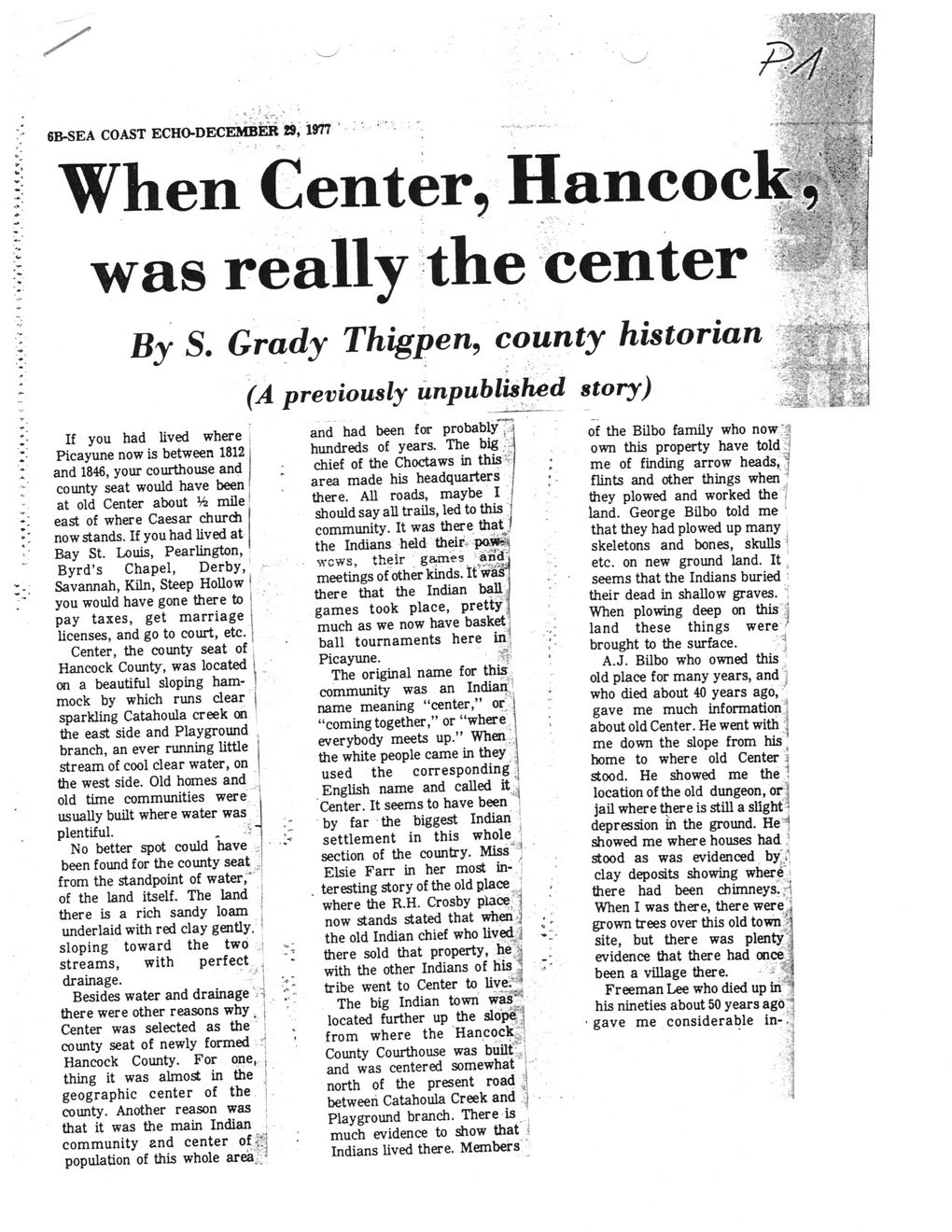This text was obtained via automated optical character recognition.
It has not been edited and may therefore contain several errors.
6B-SEA COAST ECHO-DECEMBER *9, 1977 • • When Center, Hancock - was really the center By S. Grady Thigpen9 county historian (A previously unpublished story) If you had lived where Picayune now is between 1812 and 1846, your courthouse and county seat would have been at old Center about Vi mile east of where Caesar church now stands. If you had lived at Bay St. Louis, Pearlington, Byrd’s Chapel, Derby, Savannah, Kiln, Steep Hollow you would have gone there to pay taxes, get marriage licenses, and go to court, etc. Center, the county seat of Hancock County, was located on a beautiful sloping hammock by which runs clear sparkling Catahoula creek on the east side and Playground branch, an ever running little stream of cool clear water, on the west side. Old homes and old time communities were usually built where water was plentiful. No better spot could have been found for the county seat from the standpoint of water,' of the land itself. The land there is a rich sandy loam underlaid with red clay gently sloping toward the two streams, with perfect drainage. Besides water and drainage there were other reasons why Center was selected as the county seat of newly formed Hancock County. For one thing it was almost in the geographic center of the county. Another reason was that it was the main Indian community and center of population of this whole area and had been for probably^ hundreds of years. The big ^ chief of the Choctaws in this'^ area made his headquarters there. All roads, maybe I should say all trails, led to this community. It was there that the Indians held their* paws* wows, their games 'SiiS" meetings of other kinds. It there that the Indian ball, games took place, pretty' much as we now have basket ball tournaments here in Picayune. The original name for this' community was an Indian^ name meaning “center,” or ] “coming together,” or “where everybody meets up.” When’ the white people came in they used the corresponding English name and called it Center. It seems to have been ' by far the biggest Indian settlement in this whole 1 section of the country. Miss*3* Elsie Farr in her most in- , . teresting story of the old place 1 where the R.H. Crosby place 1 now stands stated that when-j the old Indian chief who lived \ there sold that property, he $ with the other Indians of his J tribe went to Center to live. * The big Indian town was^ located further up the slope ] from where the Hancock, ' County Courthouse was built ., and was centered somewhat1': north of the present road J between Catahoula Creek and j Playground branch. There is much evidence to show that i Indians lived there. Members of the Bilbo family who now '| own this property have told ^ me of finding arrow heads, j flints and other things when they plowed and worked the 1 land. George Bilbo told me that they had plowed up many . skeletons and bones, skulls ’ etc. on new ground land. It ( seems that the Indians buried i their dead in shallow graves. ' When plowing deep on this | land these things were ' brought to the surface. 'j A.J. Bilbo who owned this old place for many years, and j who died about 40 years ago, gave me much information;! about old Center. He went with j me down the slope from his < home to where old Center x stood. He showed me the 1 location of the old dungeon, or! jail where there is still a slight < depression in the ground. He i showed me where houses had ’ stood as was evidenced by/ clay deposits showing where < there had been chimneys. ^ When I was there, there were grown trees over this old town site, but there was plenty evidence that there had once been a village there. Freeman Lee who died up in his nineties about 50 years ago^ gave me considerable in-,

Center Town Center-Hancock-Sg-Thigpen-Article-1